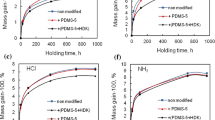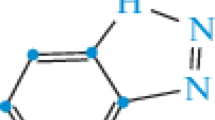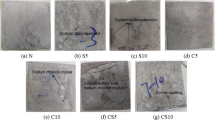Abstract
The resistance to acid-induced corrosion of inorganic polymer (including “fly ash geopolymer”) binders is examined, by exposing specimens to nitric and sulphuric acids at pH values between 1 and 3, and measuring the corroded depth as a function of exposure time. The inorganic polymer binders are shown to be affected by acid attack by surface corrosion, which contradicts some previous claims of extremely high acid resistance in such binders. Corroded depth is shown to be a more sensitive measure of the performance of inorganic polymer binders than change in mass, because acid attack on the highly-connected aluminosilicate network of an inorganic polymer binder leads to the formation of an apparently intact, but physically weak and porous, reaction product layer on the sample surface, rather than complete disappearance of the binder as is often the case for other binder types. A strong correlation between permeability and resistance to acid attack is noted across a wide range of inorganic polymer formulations, including samples based on fly ash, ground granulated blast furnace slag, and mixtures of the two. The presence of calcium (supplied either by a Class C fly ash or by slag) and of high alkali concentrations each show a positive influence on acid resistance, which is attributed to the reduction in mass transport rates through the finer and more tortuous pore networks of such binders.













Similar content being viewed by others
References
Wastiels J, Wu X, Faignet S, Patfoort G (1993) Mineral polymer based on fly ash. In: 9th International conference on solid waste management. Widener University, Philadelphia, USA
Rostami H, Brendley W (2003) Alkali ash material: a novel fly ash based cement. Environ Sci Technol 37:3454–3457
Silverstrim T, Rostami H, Larralde J, Samadi A (1997) Fly ash cementitious material and method of making a product. U.S. Patent Office, U.S. patent 5,601,643
Johnson GB (2005) Geopolymer concrete and method of preparation and casting. World Intellectual Property Organisation, World patent 2005/049522 A1
Shi C (2004) Composition of materials for production of acid resistant cement and concrete and methods thereof. U.S. Patent Office, U.S. patent 6,749,679 B2
Lloyd RR, Provis JL, van Deventer JSJ (2010) Pore solution composition and alkali diffusion in inorganic polymer cement. Cem Concr Res 40(9):1386–1392
van Deventer JSJ, Provis JL, Duxson P, Brice DG (2010) Chemical research and climate change as drivers in the commercial adoption of alkali activated materials. Waste Biomass Valoriz 1(1):145–155
Provis JL, Lloyd RR, van Deventer JSJ (2009) Mechanism and implications of acid attack on fly ash and ash/slag inorganic polymers. In: Alexander MG, Bertron A (eds) RILEM TC 211-PAE final conference, concrete in aggressive aqueous environments. RILEM, Toulouse, France, pp 88–95
Xie S, Li Q, Zhou D (2004) Investigation of the effects of acid rain on the deterioration of cement concrete using accelerated tests established in laboratory. Atmos Environ 38:4457–4466
Floyd M, Czerewko MA, Cripps JC, Spears DA (2003) Pyrite oxidation in Lower Lias Clay at concrete highway structures affected by thaumasite, Gloucestershire, UK. Cem Concr Compos 25:1015–1024
Soroka I (1979) Portland cement paste and concrete. Macmillan, London
De Belie N, Lenehan JJ, Braam CR, Svennerstedt B, Richardson M, Sonck B (2000) Durability of building materials and components in the agricultural environment, part III: concrete structures. J Agric Eng Res 76:3–16
Bertron A, Duchesne J, Escadeillas G (2007) Degradation of cement pastes by organic acids. Mater Struct 40:341–354
Chaudhary D, Liu H (2009) Influence of high temperature and high acidic conditions on geopolymeric composite material for steel pickling tanks. J Mater Sci 44:4472–4481
Davis JL, Nica D, Shields K, Roberts DJ (1998) Analysis of concrete from corroded sewer pipe. Int Biodeterior Biodegrad 42:75–84
Gutiérrez-Padilla MGD, Bielefeldt A, Ovtchinnikov S, Hernandez M, Silverstein J (2010) Biogenic sulfuric acid attack on different types of commercially produced concrete sewer pipes. Cem Concr Res 40(2):293–301
Monteny J, Vincke E, Beeldens A, De Belie A, De Belie N, Taerwe L, Van Gemert D, Verstraete W (2000) Chemical, microbiological, and in situ test methods for biogenic sulfuric acid corrosion of concrete. Cem Concr Res 30:623–634
Parker CD (1947) Species of sulphur bacteria associated with the corrosion of concrete. Nature 159:439–440
Hernandez M, Marchand EA, Roberts D, Peccia J (2002) In situ assessment of active Thiobacillus species in corroding concrete sewers using fluorescent RNA probes. Int Biodeterior Biodegrad 49:271–276
Lloyd RR, Provis JL, Smeaton KJ, van Deventer JSJ (2009) Spatial distribution of pores in fly ash-based inorganic polymer gels visualised by Wood’s metal intrusion. Microporous Mesoporous Mater 126(1-2):32–39
Criado M, Fernández-Jiménez A, De la Torre AG, Aranda MAG, Palomo A (2007) An XRD study of the effect of the SiO2/Na2O ratio on the alkali activation of fly ash. Cem Concr Res 37:671–679
Allahverdi A, Škvára F (2001) Nitric acid attack on hardened paste of geopolymeric cements: part 1. Ceramics-Silikáty 45:81–88
Bakharev T (2005) Resistance of geopolymer materials to acid attack. Cem Concr Res 35:658–670
Rinaldi A, Buzzi L, Davidovits J (1999) Application of geopolymeric cements for waste management and ecology. Results from the European research project GEOCISTEM. In: Davidovits J, Davidovits R, James C (eds) Geopolymer ‘99. Saint-Quentin, France, pp 201–209
Atkins PW, Beran JA (1992) General chemistry. Scientific American Books, New York
Beddoe RE, Dorner HW (2005) Modelling acid attack on concrete: part I. The essential mechanisms. Cem Concr Res 35:2333–2339
Shi C, Stegemann JA (2000) Acid corrosion resistance of different cementing materials. Cem Concr Res 30(5):803–808
Allahverdi A, Škvára F (2005) Sulfuric acid attack on hardened paste of geopolymer cements: part 1. Mechanism of corrosion at relatively high concentrations. Ceramics-Silikáty 49:225–229
Lloyd RR (2008) The durability of inorganic polymer cements. Ph.D. Thesis, University of Melbourne, Australia
Levenspiel O (1999) Chemical reaction engineering, 3rd edn. Wiley, New York
Bernal SA, Mejía de Gutierrez R, Pedraza AL, Provis JL, Rodríguez ED, Delvasto S (2011) Effect of binder content on the performance of alkali-activated slag concretes. Cem Concr Res 41(1):1–8
Hartman RL, Fogler HS (2007) Understanding the dissolution of zeolites. Langmuir 23(10):5477–5484
Mantri VB, Gokarn AN, Doraiswamy LK (1976) Analysis of gas–solid reactions: formulation of a general model. Chem Eng Sci 31(9):779–785
Keyte LM (2008) What’s wrong with tarong? The importance of fly ash glass chemistry in inorganic polymer synthesis. Ph.D. Thesis, University of Melbourne, Australia
Winnefeld F, Leemann A, Lucuk M, Svoboda P, Neuroth M (2010) Assessment of phase formation in alkali activated low and high calcium fly ashes in building materials. Constr Build Mater 24(6):1086–1093
Oh JE, Monteiro PJM, Jun SS, Choi S, Clark SM (2010) The evolution of strength and crystalline phases for alkali-activated ground blast furnace slag and fly ash-based geopolymers. Cem Concr Res 40(2):189–196
Lloyd RR, Provis JL, van Deventer JSJ (2009) Microscopy and microanalysis of inorganic polymer cements. 1: Remnant fly ash particles. J Mater Sci 44(2):608–619
Lloyd RR, Provis JL, van Deventer JSJ (2009) Microscopy and microanalysis of inorganic polymer cements. 2: The gel binder. J Mater Sci 44(2):620–631
Richardson M, Dodd VA, Lenehan JJ, Conaty S, O’Kiely P (1999) The influence of cement content and water/cement ratio on the durability of Portland cement concretes exposed to silage effluent. J Agric Eng Res 72:137–143
Lee WKW, van Deventer JSJ (2004) The interface between natural siliceous aggregates and geopolymers. Cem Concr Res 34:195–206
Lee WKW, van Deventer JSJ (2007) Chemical interactions between siliceous aggregates and low-Ca alkali-activated cements. Cem Concr Res 37:844–855
Asbridge AH, Page CL, Page MM (2002) Effects of metakaolin, water/binder ratio and interfacial transition zones on the microhardness of cement mortars. Cem Concr Res 32:1365–1369
Provis JL, Lukey GC, van Deventer JSJ (2005) Do geopolymers actually contain nanocrystalline zeolites? A reexamination of existing results. Chem Mater 17(12):3075–3085
Hofman F-J, Horman K, Schmidt M, Wagner E (1997) Concrete with greater resistance to acid and to biogenic sulphuric acid corrosion. Excerpt from Betonwerk + Fertigteil-Technik Heft 4/1997, Heidelberger Zement, 9 pp
Acknowledgments
This work was funded by the Australian Research Council (ARC), including partial funding via the Particulate Fluids Processing Centre, a Special Research Centre of the ARC.
Author information
Authors and Affiliations
Corresponding author
Rights and permissions
About this article
Cite this article
Lloyd, R.R., Provis, J.L. & van Deventer, J.S.J. Acid resistance of inorganic polymer binders. 1. Corrosion rate. Mater Struct 45, 1–14 (2012). https://doi.org/10.1617/s11527-011-9744-7
Received:
Accepted:
Published:
Issue Date:
DOI: https://doi.org/10.1617/s11527-011-9744-7




